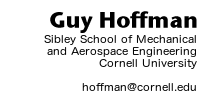This page now provides information about RA opportunities in Human-Robot Collaboration and Companionship at my new Human-Robot Collaboration lab at Cornell University. If you are a prospective or active graduate student at Cornell MAE, CS, or IS, and interested in any of the topics below, please email Guy Hoffman (hoffman@cornell.edu) with a CV and a short cover email outlining relevant skills and your interest in the project.
Also look at previous and existing research projects for additional opportunities for research projects.
New Actuators for Expressive Robotics
MAE IS
Most socially expressive robots use traditional rigid motor chains, linking rotational or linear degrees of freedom. At the same time, a host of new actuation techniques are being developed in the areas of soft robotics and actuation through deformation, including shape-memory alloys, pneumatics, and 4D printed structures. How can these techniques be used in the context of socially expressive and personal robotics, and what new interaction paradigms could be developed using these new actuators?
A Social Robotics Construction Kit
MAE CS IS
Construction kits have played a key role in the dissemination and accessibility of new technologies. With the expectation of an era of social and personal robotics, this project seeks to design a Social Robotics Construction Kit. This can be thought of as LEGO + Arduino for social robotics. Designing the parts, modules, and interaction is an interdisciplinary project including challenges in mechanical design and human-computer interaction.
Artificial Collaborative Improvisation
CS
Planning is a key concept of AI and plays a major role in human-robot collaboration. However, improvisation offers an alternative model for collaborative AI. In human-human collaboration, improvisation allows for flexible and adaptive synchronization. In human-robot interaction, improvisation was implemented in the music domain. How can we design artificial collaborative improvisation architectures to serve in non-musical collaborative tasks?
Human-Robot Collaboration Grand Challenge
MAE CS IS
Most existing AI systems for collaborative robots are piecemeal and task-specific. We need to evolve, integrate, and further study Human-Robot Collaboration (HRC) algorithms. More crucially, HRC research has not been adequately applied in full systems and across task domains. The time is ripe for a “Collaborative Robotics Grand Challenge”, unifying the efforts of HRC research, with home, office, healthcare, and educational sub-challenges. We will implement existing and new algorithms, models, and systems and evaluate them on robots in new collaborative tasks, including handovers, joint construction, and delivery, with an eye toward real-world applications.
Human-Robot Interaction “In the Wild”
MAE CS
After more than a decade of HRI research, we still know too little about robots outside the laboratory. This project will develop low-cost, multipliable, robust systems, and employ ethnographic, use-case, and longitudinal studies to drive development and test their success. We will design smartphone-powered robots to take robotic companionship research out of the laboratory and into real-world settings, investigating the notion of companionship in the context of education, service, elder care, and the workplace. We will also study the role of large-scale sensor datasets (“big data”) on home-deployed personal robotics.
Human-Robot Fluency
MAE CS
Collaborative fluency is the coordinated meshing of joint activities between members of a well-synchronized team. In this research project, we aim to build robotic agents that can work side-by-side humans by displaying the kind of fluency that humans are accustomed to from each other. In addition, despite increasing interest in collaborative fluency in the HRI community, we have been using ad-hoc, non-validated metrics to estimate the level of fluency provided by the robot, and experienced by the human collaborator. We will work to methodically define measures of collaborative fluency between a human and a robot.
Shared Autonomy for Robotic (Drumming) Prosthesis
MAE CS
We are developing a “third arm” robotic prosthesis with a first application for drumming, but with further uses for general assistance. In particular, we want to design a robotic arm that is partially controlled by the user and partially autonomous. This poses new design challenges for wearable robotics, as well as new challenges for collaborative AI.
Undergraduate Opportunities
Web Content Manager | WordPress
I’m looking for a motivated undergraduate, who would like to help build and maintain this very website. It involves migrating, managing, and maintaining large amounts of project information in WordPress.
You:
- Motivated and quick learner
- Hyper-responsible and slightly OCD
- Fluent in English
- WordPress: a big plus
- Interested in human-machine and human-robot interaction
